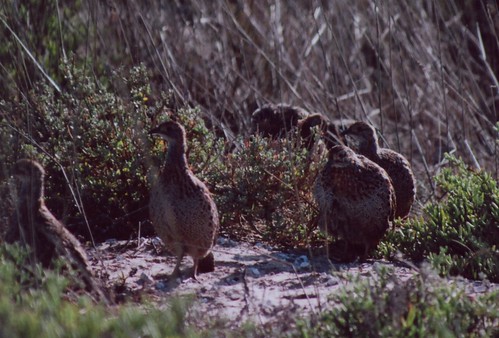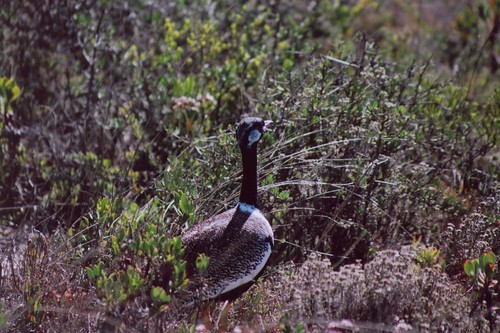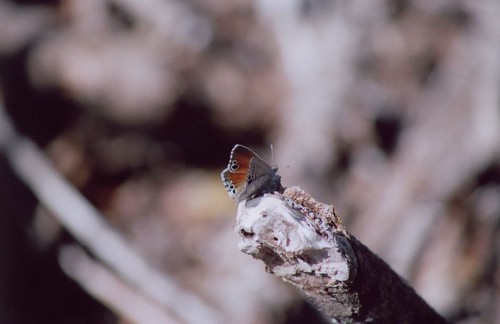
How does the Lagoon keep its colour, so clear and bright? The
Langebaan Lagoon is one of three lagoons worldwide that is nourished by the sea and not by a river. What makes the lagoon so unique is that there is no river-mouth or fresh water flowing from the land into the sea. The Lagoon exists thanks to massive changes in sea-level over millions of years. When the sea waters retreated the low lying land was covered in sea-sand. With time the wind blew to such an extent that large dunes formed along the coastline. At one stage the sea broke through the rocky hills at the mouth of Saldanha Bay and the sea into the low lying land alongside the large dunes that today form the
Langebaan Peninsula. This Peninsula is also known as the Postberg Nature Reserve and lies adjacent to the West Coast National Park. The Postberg area is only open to the public for approximately two months of the year during flower season.
The manner in which the southern winds blow surface water into the sea, has led to a welling up of deep nutrient-rich water from the Benguela current which replaces the surface water. This plankton-rich water streams into the Lagoon twice a day with the tides. With the tide streaming in and out at the Saldanha Bay entrance, as fast as 1 meter per second – the Lagoon, which is at the end of this stream, is constantly well-fed!
This nutrient-rich water has resulted in various miniature animals living in the waters and in turn these organisms attract numerous fish and birds. Millions of tiny filter-feeders such as the common sand prawn and mussels constantly filter the water and this leads to the exceptionally clear colour of the water. Young fish flourish naturally in the waters of lagoon. Flamingos are the most well known and eye-catching birds that frequent the southern wetlands constantly filtering the water for food.
The shallow waters in the southern tip of the lagoon have developed into a salt marsh which means that it has a salt content of up to three times more than sea water. This type of wetland provides essential decayed plant material which is needed in the food chain. As a result of salt marshes having a more constant salt level as well as depth level than rivers do (which can sometimes dry out), a large web of salt marshes and wetlands has developed in the southern part of the lagoon. The
Langebaan Lagoon is in fact one of the most developed salt marshes in South Africa.
In the wetlands section of the lagoon, it is estimated that each cubic centimeter contains 60 million “staafdiertjies”. This area is acknowledged as one of the most biologically productive in the world. One can thus understand why it is said that the biomass per cubic centimeter in the West Coast waters is more than the biomass per cubic centimeter found in a rain forest!
There is more than double the number of non-vertebrae organisms found in the bay of Saldanha and in the Langebaan lagoon, than in any other lagoon in South Africa. There are literally millions of “workers” that see to it that the waters are kept clean.
To top it all, the Langebaan Lagoon also has channels of differing depths and this leads to the different nuances of turquoise colouring. Some days it really looks like the lagoon has turned itself into a turquoise Peacock posing for a photograph!
Langebaan lagoon forms part of the area, approximately 100klm North West of Cape Town, that has been declared a Ramsar site (therefore of international importance). This is in the most part, due to the large number of migratory wading birds that visit Langebaan annually. The Ramsar site includes four islands, namely Schaapen, Marcus, Malgas and Jutten islands, and is where these birds breed in their thousands. Each summer the wading birds migrate from their breeding sites in Siberia and Greenland, to Langebaan where they can feed on the non-vertebrae organisms in the south of the Lagoon. It is not surprising that the birdlife of the
Langebaan lagoon is richer than any other wetland in the country.
The lagoon itself is 17km long and in an effort to preserve the delicate ecosystem, certain activities are prohibited in certain parts of the lagoon. The area closest to the entrance of the Atlantic Ocean is the least sensitive and therefore a variety of water sports are allowed by the two established yacht clubs – indeed a water-sports paradise! The middle section is a restricted recreational area where power boats and the exploitation of marine life are not allowed. The wilderness area is totally closed to the public as pollution has a detrimental affect on the salt marshes. Within the boundaries of the West Coast National Park there are proper bird hides, which allow for the viewing of birds without any disturbance to them.
With the sun setting, the sight of pleasure cruises happening on the water, are commonplace and naturally a day spent at Kraalbaai (which is more beautiful than any Greek Island!), is a memory that will stay with one forever. The most enjoyable option is set sail on a yacht around 11h00, rubber duck in tow, and then to braai (barbeque) on your yacht en route. Arrive ashore with your rubber duck and picnic at the “Preekstoel”. Children particularly, enjoy the shallow waters found at Kraalbaai (which is up to 10ºC warmer than the deep-sea waters close to the Peninsula).
As wetlands are such prime areas for coastal developments or marinas, many salt marshes are being lost. Here in the West Coast, however, there is staunch control and no industrial development is allowed in
Langebaan. As mentioned, the wilderness area of the Lagoon itself is closed and not even open to the public.
It appears as though the balance between man and nature in the
Langebaan lagoon will continue – and thus be preserved for the generations to come.
Langebaan is indeed a holiday makers’ paradise!






 Rocking the Daisies is an eco-friendly music and lifestyle festival taking place in Darling, a small town in the be-flowered Cape West Coast area.
Rocking the Daisies is an eco-friendly music and lifestyle festival taking place in Darling, a small town in the be-flowered Cape West Coast area.